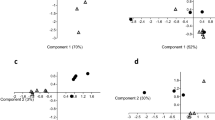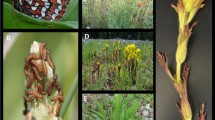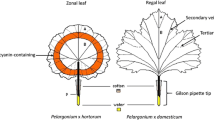Abstract
Oreina elongata is a chemically defended leaf beetle. If its food plant contains pyrrolizidine alkaloids, all life stages of the beetle sequester them. However, one of the two known host-plant genera does not contain these alkaloids. In this paper we compare the adult feeding preference and larval performance of two populations, one feeding on Adenostyles alliariae (which contains alkaloids) and one on Cirsium spinosissimum (devoid of alkaloids). Adults of the population living on C. spinosissimum preferred the alkaloid-containing A. alliariae, while adults of the population feeding on A. alliariae showed no preference for either plant. On the other hand, larval growth of both populations is better on C. spinosissimum, without alkaloids. This is especially so in the population that never naturally encounters pyrrolizidine alkaloids; the population living on A. alliariae is apparently better adapted to its host's secondary compounds. The data are discussed in terms of cost of defense and trade-offs between growth and defense.
Similar content being viewed by others
References
Appel HM, Martin MM (1992) Significance of metabolic load in the evolution of host specificity of Manduca sexta. Ecology 73:216–228
Bernays E, Graham M (1988) On the evolution of host specificity in phytophagous arthropods. Ecology 69:886–892
Bjorkmann C, Larson S (1991) Pine sawfly defence and variation in hostplant resin acids: a trade-off with growth. Ecol Entomol 16:283–289
Boppré M (1986) Insects pharmacophagously utilizing defensive plant chemicals (pyrrolizidine alkaloids). Naturwissenschaften 73:17–26
Bowers MD (1988) Plant allelochemistry and mimicry. In: Barbosa P, Letourneau DK (eds) Novel aspects of insect-plant interactions. Wiley, New York, pp 273–311
Bowers MD (1992) The evolution of unpalatability and the cost of chemical defense in insects. In: Roitberg BD, Isman MB (eds) Insect chemical ecology. An evolutionary approach. Chapman & Hall, New York, pp 216–244
Bowers MD, Collinge SK (1992) Fate of iridoid glycosides in different life stages of the buckeye, Junonia coenia (Lepidoptera: Nymphalidae). J Chem Ecol 18:817–831
Chew FS (1980) Foodplant preferences of Pieris caterpillars (Lepidoptera). Oecologia 46:347–353
Cohen JA (1985) Differences and similarities in cardenolide contents of queen and monarch butterflies in Florida and their ecological and evolutionary implications. J Chem Ecol 11:85–103
Cresswell JE, Merritt SZ, Martin MM (1992) The effect of dietary nicotine on the allocation of assimilated food to energy metabolism and growth in fourth-instar larvae of the southern armyworm, Spodoptera eridania (Lepidoptera: Noctuidae). Oecologia 89:449–453
Dobler S, Rowell-Rahier M (1994) Production of cardenolides versus sequestration of pyrrolizidine alkaloids in larvae of Oreina species. J Chem Ecol 20:555–568
Fox CW (1993) A quantitative genetic analysis of oviposition preference and larval performance on two hosts in the bruchid beetle, Callosobruchus maculatus. Evolution 47:166–175
Fox LR, Morrow PA (1981) Specialization: species property or local phenomenon? Science 211:887–893
Gould F (1979) Rapid host range evolution in a population of the phytophagous mite Tetranychus urticae Koch. Evolution 33:791–802
Gould F (1988) Genetics of pairwise and multispecies plant-herbivore coevolution. In: Spencer KC (ed) Chemical mediation of coevolution. Academic Press, San Diego, pp 13–55
Groeters FR (1993) Tests for host-associated fitness trade-offs in the milkweed-oleander aphid. Oecologia 93:406–411
Hamilton JG, Zalucki MP (1993) Interactions between a specialist herbivore, Crocidosema plebejana, and its host plants Malva parviflora and cotton, Gossypium hirsutum: larval performance. Entomol Exp Appl 66:199–205
Harshman LG, Ottea JA, Hammock BD (1991) Evolved environment-dependent expression of detoxication enzyme activity in Drosophila melanogaster. Evolution 45:791–795
Hinton HE (1981) Biology of insect eggs. Pergamon, Oxford
Isman MB (1977) Dietary influence of cardenolides on larval growth and development of the milkweed bug Oncopeltus fasciatus. J Insect Physiol 23:1183–1187
Lindroth RL, Scriber JM, Hsia MTS (1986) Differential responses of tiger swallowtail subspecies to secondary metabolites from tulip tree and quaking aspen leaves. Oecologia 70:13–19
Malcolm SB (1991) Cardenolide-mediated interactions between plants and herbivores. In: Rosenthal GA, Berenbaum MR (eds) Herbivores: their interactions with secondary plant metabolites. Academic Press, San Diego, pp 251–296
Pasteels JM (1993) The value of defensive compounds as taxonomic characteris in the classification of leaf beetles. Biochem Syst Ecol 21:135–142
Pasteels JM, Rowell-Rahier M (1991) Proximate and ultimate causes for host plant influence on chemical defense of leaf beetles (Coleoptera: Chrysomelidae). Entomol Gen 15:227–235
Pasteels JM, Rowell-Rahier M, Braekman JC, Daloze D, Duffey S (1989) Evolution of exocrine chemical defense in leaf beetles (Coleoptera: Chrysomelidae). Experientia 45:295–300
Pasteels JM, Eggenberger F, Rowell-Rahier M, Ehmke A, Hartmann T (1992) Chemical defense in chrysomelid leaf beetles: storage of host-derived pyrrolizidine alkaloids versus de novo synthesized cardenolides. Naturwissenschaften 79:521–523
Phillips PA, Barnes MM (1975) Host race formation among sympatric apple, walnut and plum populations of the codling moth, Laspeyresia pomonella. Ann Entomol Soc Am 68:1053–1060
Rossiter MC, Schultz JC, Baldwin IT (1988) Relationship among defoliation, red oak phenolics, and gypsy moth growth and reproduction. Ecology 69:267–277
Rowell-Rahier M, Pasteels JM (1986) Economics of chemical defense in Chrysomelinae. J Chem Ecol 12:1189–1203
Rowell-Rahier M, Pasteels JM (1992) Third trophic level influences of plant allelochemicals. In: Rosenthal GA, Berenbaum MR (eds) Herbivores: their interactions with secondary plant metabolites. Academic Press, San Diego, pp 243–277
Schoonhoven LM, Meerman J (1978) Metabolic cost of changes in diet and neutralization of allelochemics. Entomol Exp Appl 24:489–493
Scriber JM (1981) Sequential diets, metabolic costs, and growth of Spodoptera eridania (Lepidoptera: Noctuidae) feeding upon dill, lima bean, and cabbage. Oecologia 51:175–180
Scriber JM, Lederhouse RC, Hagen RH (1991) Foodplants and evolution within Papilio glaucus and Papilio troilus species groups (Lepidoptera: Papilionidae). In: Price PW, Lewinsohn TM, Fernandes GW, Benson WW (eds) Plant-animal interactions: evolutionary ecology in tropical and temperate regions. Wiley, New York, pp 341–373
Wasserman SD, Futuyma DJ (1981) Evolution of host plant utilization in laboratory populations of the southern cowpea weevil, Callosobruchus maculatus Fabricius (Coleoptera: Bruchidae). Evolution 35:605–617
Wiklund C (1975) The evolutionary relationship between adult oviposition preferences and larval host plant range in Papilio machaon L. Oecologia 18:185–197
Author information
Authors and Affiliations
Rights and permissions
About this article
Cite this article
Dobler, S., Rowell-Rahier, M. Response of a leaf beetle to two food plants, only one of which provides a sequestrable defensive chemical. Oecologia 97, 271–277 (1994). https://doi.org/10.1007/BF00323160
Received:
Accepted:
Issue Date:
DOI: https://doi.org/10.1007/BF00323160




